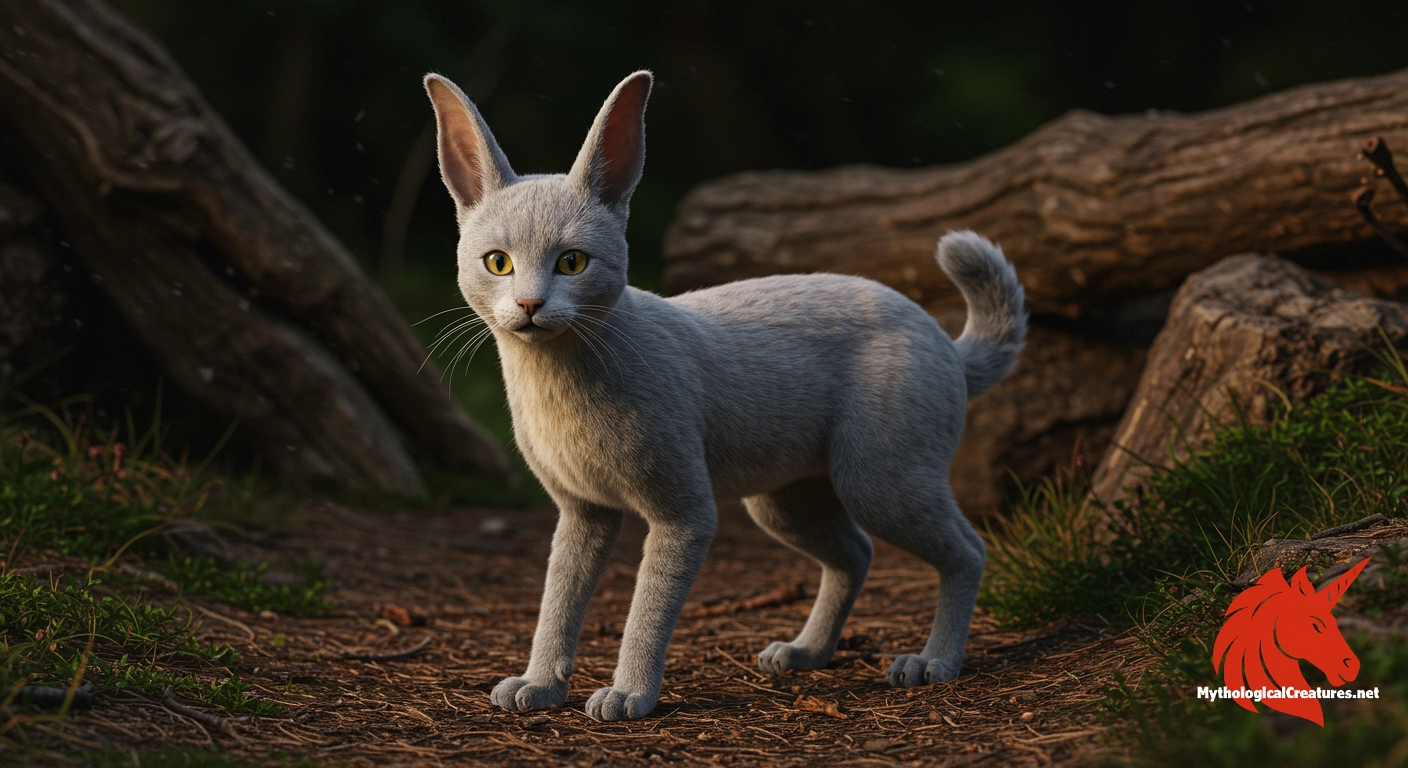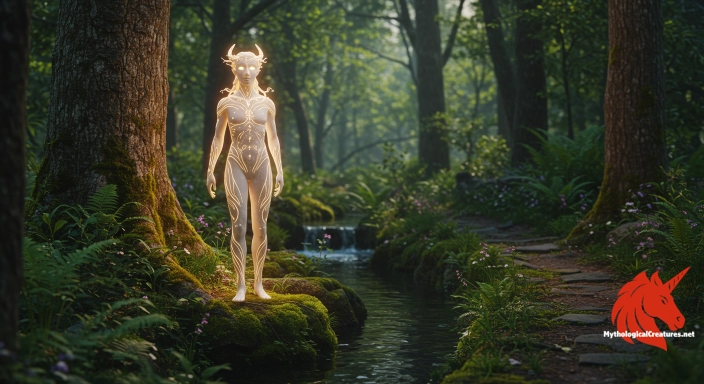Cabbit: The cabbit is a fictional creature purported to be a hybrid between a cat and a rabbit.

Cabbit
Cabbit - Represents the phenomenon of misidentification and the creation of urban legends in natural history.
Origins & First Encounters
The cabbit is a curious mythological creature that merges the sleek elegance of a cat with the gentle features of a rabbit, creating a narrative that is both enchanting and puzzling. Its very name, a portmanteau of 'cat' and 'rabbit', invites intrigue about its hybrid nature. Emerging from a tapestry of folklore, the cabbit first made its appearance in the public imagination during the mid-19th century. A noted early account from Castle Douglas in Scotland provided a glimpse into this mysterious being, intertwining regional pride with natural wonder. The creature’s origins are steeped in local tradition, reflecting a community’s attempt to explain unique animal characteristics observed in the wild. Over the decades, the cabbit has been woven into a variety of stories that blur the line between scientific observation and imaginative myth-making. Its depiction has oscillated between that of a genuine natural anomaly and a product of human error and creative fancy. As folklore evolved, the cabbit became a symbol of nature’s unpredictable quirks and the allure of the unexplainable. Many enthusiasts find the creature's ambiguous lineage a rich subject for debate, inviting both admiration and skepticism. In the end, the cabbit endures as a testament to cultural storytelling and the human fascination with hybrid forms.
Source Texts & Tale Variants
The primary documentation of the cabbit can be traced back to the mid-19th century, where early observers noted its unusual combination of traits. A seminal account by Joseph Train in 1845 in his detailed record of the Isle of Man sparked enduring interest. This initial observation was rooted in a misinterpretation of the Manx cat’s distinctive features, particularly its short, tufted tail reminiscent of a rabbit’s. Subsequent narratives have rehashed similar descriptions, often blurring the lines between biological possibility and the imaginative leaps of folklore. In later years, a specimen exhibited in New Mexico and showcased on national television further bolstered the cabbit legend, even though modern science later confirmed it as a deformed cat. Various folkloric texts and regional anecdotes have added to the maze of conflicting details surrounding this creature. Despite the lack of credible scientific validation, these accounts have persisted, propelled by local eyewitness testimonies and the allure of the mysterious. Some historical texts present multiple variants of the story, each adding its own embellishments to the creature’s supposed anatomy and behaviour. This rich tapestry of sources underscores how the cabbit has become as much a fixture of myth as a subject of cryptozoological curiosity. The enduring nature of these accounts reminds us that sometimes a legend can gain a life of its own beyond the confines of scientific possibility.
Form & Powers
The cabbit is typically depicted as a creature that marries the lithe body of a cat with several unmistakable rabbit characteristics. Its silhouette is defined by a compact feline frame endowed with a short, tufted tail that mirrors the softness of a rabbit’s fur. In many descriptions, the creature is said to possess delicately elongated ears that hint at its lagomorph influence while retaining the alert, piercing eyes of a cat. The texture of its coat is often portrayed as a patchwork of hues, blending the sleek smoothness of a domestic cat with the downy quality usually associated with rabbits. Variations in size have been noted, with some accounts suggesting a more robust build than a typical house cat, yet still agile enough to embody the nimbleness of its feline side. Observers have remarked upon the creature’s balanced proportions, where the forelimbs exude the finesse of a cat while the hind limbs hint at the strength needed for a rabbit’s quick leaps. Certain artistic renditions even suggest subtle differences in the creature’s skeletal structure, contributing to its enigmatic appearance. The overall physicality of the cabbit creates an impression of a creature that defies conventional biological limits. These detailed physical traits have inspired numerous illustrations that capture both its charm and its inherent improbability. As a result, the cabbit continues to serve as a fascinating subject for both scientific critique and creative reinterpretation.
Regional Faces
Different regions have embraced the cabbit legend in ways that reflect their own cultural and natural landscapes. In Scotland and the surrounding areas of the Isle of Man, local folklore quickly intertwined with this creature’s mythos, largely due to the perceived resemblance between the Manx cat and a rabbit. In these locales, the cabbit is often depicted as a mysterious denizen of the rugged countryside, its features magnified by the local penchant for storytelling. Across the Atlantic, in parts of North America, the creature was reimagined during mid-20th-century exhibitions as a novelty, frequently appearing in travelling shows and on television screens. Here, the focus shifted to its role as a subject of curiosity rather than a genuine biological oddity, highlighting regional differences in how such hybrids are interpreted. European accounts, in contrast, have often leaned towards an analytical perspective, using the cabbit as a case study in the misinterpretation of natural phenomena. In modern urban legends, the creature has found a place among other folkloric oddities, adapted to reflect contemporary themes of uncertainty and wonder. Regional reinterpretations continue to evolve, with artists and storytellers adding local colour and nuance to the core legend. Such diverse portrayals reflect the flexible nature of the cabbit myth, capable of absorbing and reflecting varying cultural attitudes toward nature and the unexplained.
Cultural Parallels
The cabbit occupies a distinctive niche in the realm of mythological hybrids, standing alongside creatures that blur the boundaries between disparate species. Its unusual combination of traits invites comparisons with the jackalope, another emblematic creature from American folklore known for merging features of rabbits with those of other animals. Like many hybrid legends—from the centaur to the mermaid—the cabbit challenges conventional classifications and sparks dialogue on the nature of transformation in myth. This creature also echoes themes found in other cultural apparitions where the merger of characteristics creates a being that is both familiar and fantastically altered. While many mythical hybrids serve as metaphors for the integration of opposing forces, the cabbit uniquely combines an element of domestic familiarity with an aura of wild, unclassifiable mystery. Its existence, though debunked scientifically, mirrors the playful and inventive aspects of human creativity found in other folkloric cross-breeds. Such comparative analysis reveals that while the cabbit might not hold the stature of more prominent mythic beings, it nonetheless occupies an important space in the broader dialogue on animal hybrids. The cross-cultural tendency to reimagine inherent animal traits into hybrid forms underscores a universal fascination with the boundaries of nature. In this light, the cabbit emerges as a charming yet puzzling reflection of our collective urge to explore the liminal spaces between reality and fantasy.
Legacy & Modern Evolution
The historical evolution of the cabbit underscores a fascinating journey from earnest natural inquiry to its eventual place as a pop culture icon. What began as a misinterpreted observation in the 19th century has transformed into a narrative rich with imaginative flair and enduring mystery. Early accounts once sought to classify the creature as a bona fide biological anomaly, only to later be debunked with advances in science and genetic understanding. Over the decades, the cabbit has found its way into modern media, from television showcases to internet memes, capturing the public’s imagination with its peculiar charm. Contemporary fantasy art and literature have embraced the cabbit, often portraying it as a whimsical symbol of nature’s unpredictability and the allure of myth. This modern reinterpretation reflects a broader cultural trend where once-disputed creatures are celebrated for their narrative value rather than scientific validity. The cabbit thus stands as a testament to the power of folklore in shaping our perceptions of the natural world. It also reminds us that human fascination with the mysterious often endures beyond rigorous empirical scrutiny. As society continues to blend science with storytelling, the legacy of the cabbit remains an enduring emblem of creativity, doubt, and the playful spirit of myth-making. In its evolution from historical misidentification to modern iconography, the cabbit encapsulates the timeless interplay between fact, fancy, and the enduring magic of a well-told story.
Interesting Fact
Notably, the cabbit has evolved into a cultural reference point symbolising the potential for misinterpretation in wildlife observation and science.
Quick Creature Info
Features:
Our Mythic Legendary Rating:

Also Sometimes Known As:
Physical Attributes:
Behavior:
Lore:
Related Creatures, Tales or Lore
References
Discover Another Mythical Legend You May Not Have Heard Of?
Uncover the mysteries of ancient folklore and expand your knowledge of legendary beings from cultures around the world.
Dare to Meet the Dercetis....
Curated by the Mythological Creatures Team (rev. May 2025)
